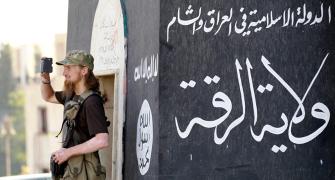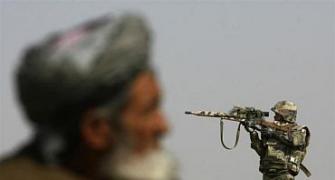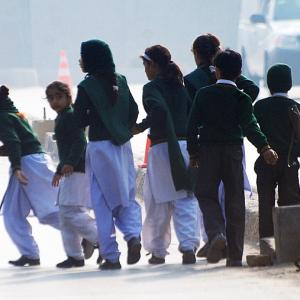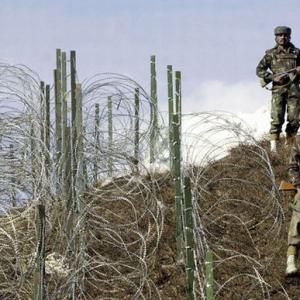'It is a very hard won situation that the army has brought about in J&K in 25 years, we don't want to fritter it away...'
'By 2010-2012 the terrorist strength had come down to 300, 400. From a high of 3,000 to 4,000 to 300 to 400 was no mean achievement for the army,' says Lieutenant General Syed Ata Hasnain (retd).
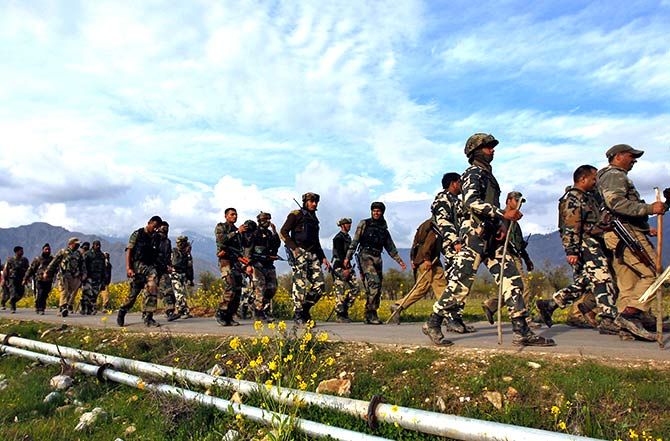
The last two years have seen relative peace in Jammu and Kashmir, paving the way to the highest-ever voter turnout in 25 years in the election held three months ago.
It is a historic achievement for a state rocked by turbulence and torn by a long-drawn conflict.
The current peace -- and one must always remember that peace in Kashmir is precariously fragile -- has once again highlighted the debate about the reduction of troops from J&K.
In a state which continues to have one of the highest concentration of military personnel anywhere in the world -- has time come to replace the army by the police in certain areas?
What has been the Indian Army's achievements and how successful has it been in winning the hearts and minds of the people.
Most importantly, are we any closer towards a resolution of the Kashmir conflict?
For an indepth view of the security situation and the challenges ahead, Rediff.com spoke to Lieutenant General Syed Ata Hasnain (retd), who has served seven tenures as a soldier in Jammu and Kashmir.
From Kargil, Poonch, Siachen, Chushul to Awantipur, Uri, Baramullah and Srinagar, General Hasnain, has served in all three regions of the state -- Jammu, Kashmir and Ladakh.
A second generation army officer, General Hasnain is currently a Visiting Fellow at the Vivekanand International Foundation and a Senior Fellow at the Delhi Policy Group.
In an interview to Archana Masih/Rediff.com he spoke about the Indian Army making a dent in winning the hearts of the Kashmiris; why AFSPA is not as draconian as it is made out to be; and how the people of Kashmir and the rest of India have common past and a common destiny.
- Part I of the interview: 'This is the best formula that can happen in J&K'
Do you see the army being replaced by the police in some areas in Jammu and Kashmir in this government's tenure?
Ultimately that is the situation that should emerge right at the end, at the termination of conflict when we presume that there is no internal conflict.
The army should be back on the Line of Control, the hinterland should be in the control of the police and Central Armed Police Forces, but that is a pipe dream. Till that happens and to insure that that comes about, you have to go progressively.
To say that the time to commence such a progression is now is difficult to presume.
No doubt that the BJP (Bharatiya Janata Party) has accepted that there will be some kind of a drawdown by which replacement of the army will take place by the police in certain areas.
I think a lot of time will have to be spent on the identification of these areas and the concept of operations thereafter.
Mainly these areas will be in Jammu, I suppose. I don't think there is any such area in the Kashmir Valley.
It is not just a black and white situation that so and so district is now free of violence and therefore should be taken over by the police.
It is much more complex and only people who operate there everyday really perceive the dangers of a situation without the army's presence.
24x7/365 days, the army moves convoys to Ladakh, Kupwara, Gulmarg, Uri and many places. These roads have to be made secure. Ladakh's civil population also depends on this secure communication.
Many of these areas, which are being looked as peaceful, are the areas through which our convoys move. Is the police in a position to guarantee us security?
They haven't been able to give us this guarantee in the last few years in which people say the situation has improved so much and I am not sure if they can guarantee us this today.
We have to be realistic because we are playing with lives. We are playing with national security. Do remember that our adversaries have not vanished nor has all the infrastructure for infiltration.
Anyway who needs infiltration when you have enough surrendered terrorists sitting in the hinterland fuming at the lack of deliverance of all the promises that the previous governments made?
It is a very hard won situation that the army has brought about in 25 years, we don't want to fritter it away.
I am not being negative about it, but we have to think through this very, very carefully.
The contentious issue of AFSPA will continue to be debated...
Our adversaries, separatists, whoever is against the interest of India has exploited the wordings of this Act to make it sound as if it is the most draconian Act in the world. I can prove it that it is not.
There has to be a different way of looking at it. Should the Act that was enacted for 1990 when the situation was very different, be applied in letter and spirit in exactly the same way in 2015?
Or do we require a different instrument which empowers and protects the army and allows it to operate without any problems.
I am sure 2015 is a watershed moment when the entire concept of internal conflict in J&K should be changing.
If politics is changing, so should your concept of fighting internal conflict.
So it should be changing its wording in keeping with the ground situation in 2015?
The text that has been exploited by so many anti-India elements and put the army and nation on the backfoot, that text in many ways has been countered by the situation that has emerged since 1997.
The 1996 elections brought about a democratically elected government and in '97 we had for the first time an agitation against AFSPA. That led to the Supreme Court drafting out and giving to the army a set of Dos and Don'ts which is the rules and engagements of working under AFSPA.
Based on this, the army came out with standard operating procedures to ensure that AFSPA could not be exploited. These are the procedures under which the army functions today.
In 1997, we started Sadhbhavna 1. It became the public outreach of the army. If you look at AFSPA in the original text and compare it with these three things -- the Supreme Court's Dos and Don'ts, the Northern Command's SOPs (Standard Operating Procedures) for the rules of engagement and the operating philosophy of Sadhbhavana -- then all that sounds draconian in AFSPA, has actually been balanced by all these three that are not in the text of the Act.
If you redo this Act under a different name and have these three things put into the text, the world will know that there are mitigating factors besides so-called draconian aspects of the law and there are watch dogs who are observing all the time.
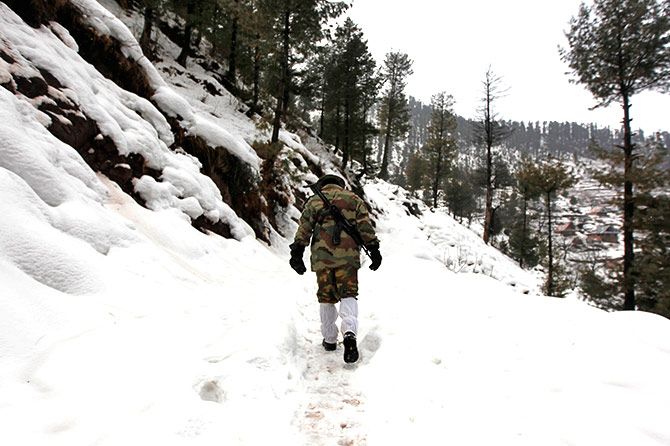
You have said in the past that the army has done its work well in J&K; however, it has been successful in eliminating terrorists, but not terrorism. As an officer who has served from a colonel to brigadier to lieutenant general in J&K, how has the situation improved?
When you say J&K, you have to see both sides of the Pir Panjal -- Jammu region and Kashmir region. Ethnically, demographically, there is a difference between both the regions.
Separatism has been very strong in the Valley. It is only in the upper parts of the Jammu region that separatism was existent. This was brought to a head by the proxy war sponsored by our neighbour -- financial conduits, arms running, drugs -- all this was brought into it to fight this conflict with us.
This conflict had to be fought out with a certain number of foot terrorists on the ground and there were 3,000, 4,000 of them inside the Kashmir and Jammu regions.
Such situations start with conflict initiation, subsequently they proceed through conflict progression, then to conflict stabilisation and then to conflict resolution and termination.
Today we are at a near conflict resolution state. The termination state has to be completely political with the army only holding the periphery.
The classic example is the Northern Ireland conflict which was fought entirely on economics. After the Good Friday Agreement the British government brought in tremendous amount of development, the economic agenda played out and people forgot the internal dissensions.
Something similar is happening in J&K. In a long drawn conflict, those who suffer most are the people and it is s an abnormal environment in which people grow.
Having said that, the first point is that you have to reduce the terrorist numbers. I think the best decision came in 2003 when General (N C) Vij had the LoC fence constructed.
After it was completed in 2004, you found the army was eliminating more terrorists inside the hinterland than the number of terrorists who could infiltrate.
You had a control of infiltration and the number of terrorists in the hinterland started dwindling.
By 2010-2012 the terrorist strength had come down to 300, 400. From a high of 3,000 to 4,000 to 300 to 400 was no mean achievement for the army.
But it is the last mile, the killing of the last terrorist, which is most problematic. You have to work over time for it.
That is the situation we are in today.
Having reduced the strength of terrorists, having restored democracy and having created excitement about the return of the political-social-economic agenda -- has been the greatest achievement of the army.
The politics of J&K have also progressed since 1996 and we have come to a stage in 2015 where the state is forming a government with two sides of Jammu and Kashmir.
This is huge progress and the army's contribution should not merely be seen as only the elimination of terrorist numbers.
The army contribution has hugely been in the social sphere where through the '90s and the early part of millennium when administrators could not even go into the field, it was the army that went everywhere and delivered every time there was a failure of governance and in creating a positive impression about India through Sadhbhavna.
Most importantly, the army has held the periphery and kept the stability to allow the political process to take shape.
At what stage has the effort to win the hearts and minds of people reached and how much ground yet remains to be covered?
The hearts and minds of the people are fought for both by the army and the terrorists.
In this case we have been able to win over much of the hearts and minds of the people, but I would say at the current juncture we have made a dent.
We have to go far ahead and we must not lose our way. We must ensure that we have continuity of policy.
Today hard power based military operations are 20% of the effort, 80% is about how to get to the people and have proper outreach to empower the people, the government of J&K and civil administration.
Ultimately, the whole agenda is a national agenda.
25 years of conflict is not a short period. A whole generation has gone through this negative cycle of violence. This is what we have to work on over time.
The army can take the leadership and initiative, but we have to take it beyond.
We have to take politicians, army, administrators, educationists, academics, media, psychologist -- the whole of the nation approach, it can't be the army's approach.
People of J&K have often articulated a sense of victimisation by India in general and by the army in particular. How much has that situation changed and how has that inhibited the working of the state?
Effort has to be made towards sensitisation that this part of the country has suffered. We have to make the people forget that suffering and move towards mainstreaming and integration.
The people of India have a role in that and must build a positive environment for the people of J&K who are coming out of the state. I would not say that alone for J&K, but also for the Northeast.
We are a young nation and still in the process, but we have achieved much. These pinpricks will be there and the GoI must more proactively follow a perception management programme to create a positive environment and understanding, particularly for the remoter areas of the country.
More than the kinetics of the application of the army or development agenda, it is psychology.
The psyche of the people has to be targeted by a subtle information management programme to tell the people in the rest of India and Kashmir that you are the same people with a common past and a common destiny.
Public Information and Perception Management has never been a strong point with the GoI; with so much changing under the current government I hope this aspect gets its due.
Rediff Recommends:

